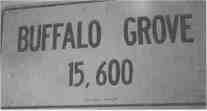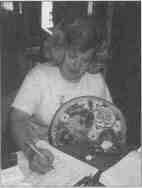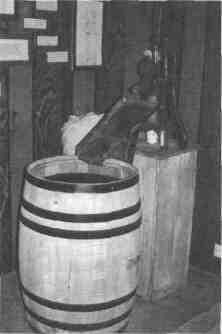SPECIAL FOCUS
A Tale of Two Museums
Morton Grove's and Buffalo Grove's fledgling museums took flight
when they joined forces and shared resources
BY JANET NOWERS AND GARY F. BALLING, CLP
|

|
Photo: Like the small,
park district museum that
captures its history, Buffalo
Grove has experienced
tremendous growth in a short
period of time. Village
population in 1958 was 164.
The early '70s showed growth to
more than 15,000, as recorded
by this sign from the Raupp
Memorial Museum collection.
Today Buffalo Grove's
population tops 43,136.
|
Small, district-owned museums have a tough go of
things on their own. But, by sharing resources these
local treasures can gain efficiency and visitors.
A cooperative agreement developed in 1994
between the Buffalo Grove and Morton Grove park
districts created just such a worthwhile collaboration.
At the heart of the agreement was the hiring of one
full-time person as curator for both museums, the
Haupt-Yehl House in Morton Grove and the Raupp
Memorial Museum in Buffalo Grove.
Here's a look at their early struggles and creative
solutions for growth.
Buffalo Grove "Grows" a Museum
The initial drive to preserve and honor the life of
an earlier Buffalo Grove was not the vision of the
Buffalo Grove Park District, but was guided by one
of the village's first settling families, the Raupps. One
could say they had a crystal ball for predicting the
future. It was their desire that a museum be built on
a portion of the family homestead they once farmed.
This museum would show its visitors, through
exhibits, displays and programs, an earlier, simpler
life. Few people, especially
children, could understand the
contrast between a frugal lifestyle
and what was quickly becoming
an instant, throwaway society.
To fulfill the Raupp's vision, 3.5
acres of farmland were donated
to the village. In 1971 the village
deeded the land to the park
district, and it was the park district that carried out
the wishes of the family.
Initially, the museum was to have been housed in
the Raupp farmhouse, but in early 1972 the house
caught fire and could not be restored. The Raupp
dream for a museum was then put on hold until
1975 when Leavitt Development Company donated
their sales office to the park district for the purpose of
the museum. Through the work of volunteers, a
small community museum took shape, and in 1979
the museum was officially dedicated.
The Raupp Memorial Museum, like so many small
museums, was managed at first by a volunteer
curator and a small volunteer staff. This corps of
community volunteers was successful in obtaining
artifacts and developing early exhibits. Unfortunately,
none of these individuals knew much about the
proper management or administration of a museum.
The board of park commissioners, who were
immersed with the rapid growth of a young park
district, trusted the volunteer curator to make
decisions. These decisions did not always reflect the
museum's needs.
In 1992 the park commissioners discovered they
could no longer rely on a volunteer curator to
manage the museum. The reasons were many. Since
1979, the museum was only open on Sundays and
only for three hours. Museum programs were no
longer offered and tours were rarely booked by
community organizations. The schools were not
using the facility. Although objects were collected,
there were no collection policies. Proper conservation
32/ Illinois Parks and Recreation
and storage were not being utilized.
Most notable was the fact that key volunteers had
left or had died, leaving only the volunteer curator to
supervise Sunday public hours. If he was unavailable,
the museum didn't open. Thankfully, the park
district had five elected commissioners who realized
that this facility could become a significant resource
for the district and the community. And they
resolved to make changes.
Important decisions by the commissioners
included a change in staffing. The volunteer curator
was encouraged to continue his work at the museum, however a park district staff member would
oversee his work. This staff member eventually
became the museum manager with the responsibility
for turning this fledgling museum into an integral
community resource.
A Partnership Is Born
It's one thing to have an interest in a museum, but
to have the responsibility of overseeing its operation
is much different. The Raupp Memorial Museum,
from the beginning, had been without professional
management. To turn it into a recognizable, frequently utilized facility was not going to happen
overnight. The staff person in charge knew little
about the operation of this museum, or any museum
for that matter, so she started asking questions and
discovered how different it would be from managing
other "recreational facilities."
The primary concern of any museum is not for the
visitor, but for the collection. Without a collection,
there is no museum. Collections must be cared for
properly, cataloging procedures adhered to, and
collection policies established. The efficiency of the
entire structure, its lighting, its heating and cooling
system, was also a major consideration for the proper
care of the collection.
And that is just the beginning. An exhibition
philosophy should be written, and new exhibits
developed and properly maintained. An educational
philosophy is also necessary. New tour and educational programs must also be developed as well as
recruiting volunteers and other projects.
If the management of a museum was an eye-opening experience for Buffalo Grove, how were
other park districts with small museums handling
their operations?
One such small museum, operated by the Morton
Grove Park District, was at a similar turning point as
the Raupp Memorial Museum. The Morton Grove
Historical Museum in the Haupt-Yehl House was
also being managed by volunteers who had limited
knowledge about proper museum procedures. Public
hours were limited. Tours were few and dollars short.
|
Morton Grove "Grows" a Museum
From the beginning, the successful preservation of the Haupt-Yehl
House for a museum inched forward with emotions running high. In
the spring of 1984, resident Dorothy Yehl donated the home to the
Morton Grove Historical Society and sold the land to a developer,
leaving just weeks to save the house from destruction. It was to be
moved or razed.
The historical society wanted to relocate the 100-year-old home to
Harrer Park and call it the
Morton Grove Historical
Museum. Commissioners for
the Morton Grove Park
District unanimously agreed
to allow the home to be placed
on park property if the
historical society could raise
more than $50,000 to move
the house and set it on a new
foundation.
In August that same year,
the house was moved, restored and
operated by the historical society.
In November, a museum advisory
committee was formed with
representatives of the park district,
historical society, village of Morton
Grove, Morton Grove Library and
a local school district. The park
board was to have final say on all
matters concerning the house.
For several years poor communication and
cooperation ensued. A very low level of trust
among the groups had become ingrained.
Then, in 1988, a Letter of Agreement was
established between the park district and
historical society creating a Museum Council
made up of representatives from both entities.
With the new council in place, it was time to
get things back on track. A grant from the
American Association of Museums provided an
assessment of the museum operations and its
activities. Three objectives were identified: 1) to
properly identify and manage collections; 2)
improve displays and provide activities, and 3)
seek additional qualified personnel. The
assessment was the first step in identifying the
need to transition from an all-volunteer staff to
paid, professional employees.
Today, the Haupt-Yehl House is furnished to
reflect the early years of this century when
|

Before: Dorothy Yehl's home is
prepared to be moved to
Harrer Park in 1984.
|

After:The renovated museum is
decked out for the holidays.
(continued on page 34)
|
|
January/February 1999 /33
|
Morton Grove "Grows" a Museum
(continued from page 33)
|

|
Morton Grove was still young. A
typical farmhouse of the Germans
who settled this area, it contains
many of the everyday household
items used by local families in 1888,
the year the home was built.
Exhibits and displays continually
change. The museum welcomes
group tours and offers programs for
public presentations. Many of the
museum's volunteers, such as
Sharon Holihan featured in the
photograph, are society members
and residents of Morton Grove.
Morton Grove's heritage is being maintained at the museum by a
Museum Council, guided in a cooperative effort by members of the
historical society and the park district. Proper care and management of
collections are directed by a dedicated museum curator. Goals for 1999
include continued computerized cataloging of collections, completion
of a volunteer manual, an educators open house and a special exhibit
to be opened in the fall. •
|
The Morton Grove Historical Museum in the Haupt-Yehl House is located in the Morton Grove Park District's
Harrer Park. Hours are Sundays 2 p.m. to 4 p.m., Wednesdays 1 p.m. to 3 p.m. or by appointment. Groups
tours are by appointment only and admission is always free. For more information, call 847.965.0203.
|
After several meetings, it was determined that a
partnership between the two museums would be
beneficial in several ways. We determined first that if
both park districts hired one museum professional,
staff salaries and benefits could be split between both
agencies. In addition, the purchase of conservation
supplies and training expenses could also be shared.
Secondly, by forming this agreement, both museums
could begin to show positive growth and look to the
day when there would be separate professional staff
members at both museums.
Since museum dollars were already tight, it was
determined that the best way to approach our staffing
concern would be to work with universities who offer
a museum internship program. This person could
initiate positive growth, leading the way for the hiring
of a professional staff member in the future.
Both districts had a desire to improve the efficiency
of services provided and increase the number of
visitors to their museums. At the heart of the agreement was the hiring of one full-time person to be the curator of both local museums. The curator would be
the first individual designated and hired with training
in museum collections and care.
On May 23, 1994, the board of the Buffalo Grove
Park District signed an intergovernmental agreement
with Morton Grove Park District which formed a
museum partnership. The agreement involved
sharing the services of an intern and the eventual
hiring of a museum coordinator for both museums.
The Intern Experience
One of our best resources for gaining an understanding of museum science came from Joy
Matthiessen, director of the Des Plaines Historical
Museum. Matthiessen became our mentor as we
struggled to gain information on various museum
operations and for determining the best way to go
about looking for an intern.
Another resource was the Illinois Heritage
Association located in Champaign, Ill., which
advised us to advertise for an intern through Eastern
Illinois University. Eastern has one of the best
graduate study programs in Historical Administration
in the Midwest.
Fortunately, our first request for a graduate student
met with success, and the intern began a 12-week
program in June of 1994. The intern would be
responsible for several key projects, among them the
creation of a hands-on area for children at the Raupp
Memorial Museum and the development of collection cataloging procedures for the Haupt-Yehl House.
To many, the task of managing two museums
would seem overwhelming. However, to a student
from the Historical Administration program at
Eastern Illinois University, this was a challenge that
was quite appealing. It would provide firsthand
training that would be invaluable for future full-rime
employment.
From the intern, both park districts learned a great
deal about the administration of a museum, proper
collections management and numerous technical
skills. Unfortunately, the museum professional
viewed the nontraditional museum within the park
district setting with some impatience.
For one, the museum was not recognized by either
park district as their most important facility, and this
was frustrating for the museum professional. Work
requests took several weeks or months to complete as
park district crews prioritized their projects by need
and importance. Secondly, visitors were not viewed
with equal importance to that of collections; without
visitors, there is no need for a museum. Thirdly,
money was always in short supply.
These and other considerations were at first
difficult for the museum professional, but were
overcome with education and an understanding of
34/ Illinois Parks and Recreation
the park district structure and philosophy. Likewise,
park districts are now recognizing the museum
profession as an important asset to their museum
operations and are pleased to include these individuals as part of the park district family. After all, a
museum offers an alternative source of recreational
opportunities and education.
Creativity and Perseverance Lead
To Growing Museums
|

Photo: The discovery room in the Raupp
Memorial Museum allows visitors the
opportunity to play with old-time toys, dress in
period clothing, wring out clothes by hand as
well as pump wafer by hand. A facility of the
Buffalo Grove Park District, the museum is
located at 901 Dunham Lane in Buffalo Grove.
Public hours are Sundays 1 to 4 p.m., Monday
through Wednesday 2 p.m. to 5 p.m. and the
second Wednesday of each month, 7 a.m. to
8:30 p.m. Admission is free. For tour
information, call 847.459.5700, ext. 116.
|
Since 1994, attendance at the Raupp Memorial
Museum has grown 60 percent. Three major exhibits
have opened to the public with notable community
response. Two new tour programs, "Packing for Pioneer Life"
and "Buffalo Grove—Then and Now," have
been introduced and are now being utilized by all grade
schools. Community special events such as the "Old-
Fashioned 4th of July Celebration" have renewed interest in the
museum and its programs. Museum classes
including quilting, genealogy and local history programs
are being offered.
With a full-time curator, the museum is now open
four days a week. A Conservation Assessment Grant
was received. And, due to this progress, the Buffalo
Grove Park District board of commissioners is
hoping to expand the current museum building in
1999 to accomplish even more.
Likewise, the Morton Grove Historical Museum
has matured and become a focal point for community-wide events. For example, the museum took
center stage at the Morton Grove Autumnfest held
last fall in Harrer Park. The museum featured an
exhibit looking back on Morton Grove days since it
began in the 1930s. Bus tours were provided by the
Historical Society through the old sections of town,
reminiscing about the early business district and
notable people living in Morton Grove over the
years such as actress Marlee Matlin and gymnast
Bart Conner.
|
Also, last August curator Mary Walsh was hired.
Walsh will use her extensive teaching experience to
bring museum services to local schools as well as
drawing more residents of all ages to the museum.
Today, both the Morton Grove and Buffalo Grove
museums have grown beyond the need to share
staff. Both function independently of each other
with separate curators on staff. Yes, intergovernmental agreements do work. •
JANET NOWERS
is the administrative assistant and museum manager of the Buffalo Grove Park
District.
GARY F. BALLING, CLP
is the administrative manager of the Morton Grove Park District.
|
Comments from a Museum Mentor
BY JOY MATTHIESSEN
The "first professional"—as we in the field often refer to the first new
hire in a museum that had been previously all volunteer-run—is seldom
an easy position. Generally, it is an educational experience for everyone
involved: from learning the buzzwords like "acid-free tissue" or "buffered
paper," to the need for climate control and the use of hygrothermographs.
Creating a balance between "what was" and realizing what is the full
potential of the museum facility is usually a process that evolves over
time and necessitates both patience and dialog between the parties
involved. The Morton Grove and Buffalo Grove museums were no
exception.
Each facility made significant progress in terms of becoming more
"museum-minded." This was especially noticeable in their exhibit and
storage areas as well as in the realm of artifact record-keeping and
documentation. Their unique collaboration was an excellent starting
point enabling each to gain a better sense of their needs and formulate
future direction.
As we have found, to the benefit of both park districts, intergovernmental agreements can work. •
JOY MATTHIESSEN
is the director of the Des Plaines Historical Museum and served as a
valuable mentor for the Buffalo Grove and Morton Grove museums.
|
January/February 1999 /35




